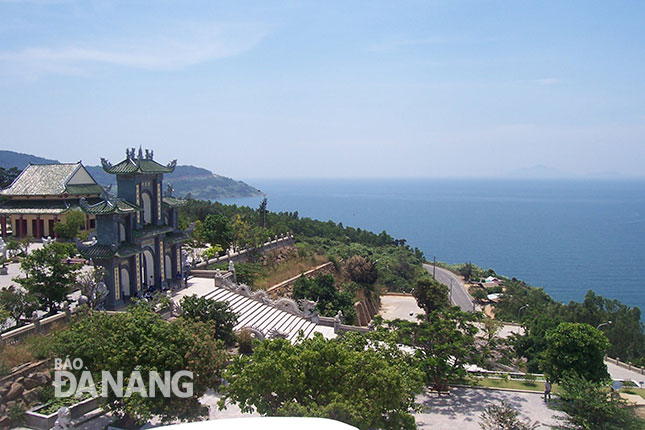Ways to boost tourism development
Tourism has been seen as a key sector for the Da Nang economy, but a tough question raised here is how to develop this lucrative aspect in a sustainable and intensive manner, and fully tap this sector’s potential in association with environmental protection.
 |
| The Linh Ung Pagoda on the Son Tra Peninsula are very attractive to domestic and foreign visitors (Photo: Minh Tri) |
The city is now in need of more incentive strategies in order to realise its ambition of becoming an international tourism hub, thereby making itself on par with other renowned destinations worldwide as Bali, Phukhet, Maldive and Hawaii in the future.
At present, the seaside city is now focusing on fostering the progress of 3 main tourism categories: marine, luxury holiday and shopping tourism; MICE (Meetings, Incentives, Conferences and Exhibitions) tourism; and heritage, cultural, historical, spiritual, medical and eco-tourism.
According to local tourism experts, it is highly recommended to develop ‘city break’, which is a short holiday spent in a city in the coming time.
This model, which has already been added to the national tourism product development strategies by 2025, is expected to encourage domestic and foreign visitors to extend their stay periods here, return later, and recommend Da Nang to others, and increase the revenue from tourism as well.
Of note, as long as Da Nang becomes a ‘hub city’ showing off modern infrastructure systems and convenient transportation via roads, railways, airways, waterways and seaports, the ‘city break’ would thrive.
To date, the great tourism development potential of the Son Tra Peninsula, the Da Nang Bay, the Hai Van Pass, and areas along the Cu De and Tuy Loan rivers has yet to be fully tapped.
From the perspectives of local tourism experts, it is suggested that the Son Tra Peninsula should be turned into a national ecological park featuring scenic bike trails and internal walkways for admiring red-shanked douc langurs and birds.
It is also a time to develop the Da Nang Bay into an ideal place for those who love such beach activities as canoeing, kayaking, fishing, diving to explore the coral reefs, paragliding, and wind surfing.
Effective measuures should be taken to turn beaches at the foot of the Hai Van Pass and the Son Tra Peninsula into new tourist areas, namely Lang Van, Da Ben Black Rock), Sung Co, and Bai Cat Vang (Yellow Sand Beach).
Special heed should be paid to creating places for spiritual and medical tourism, and vacation areas exclusively for the elderly, and open tours to time-honoured traditional craft villages, and the Co Tu ethnic minority villages along the Cu De and Tuy Loan rivers.
With regard to infrastructure, it is necessary to promptly build expressways connecting Da Nang with other localities in Central Viet Nam and Highlands, and some Lao localities through the Dak Oc border gate.
Work should start as soon as possible on the relocation of the city’s railway station, whilst the dredging of the Co Co River which runs through Da Nang and Hoi An, should be conducted in order to open up an opportunity to develop the tourism sector in the 2 localities.
The Tien Sa Port should be developed into a cruise ship centre and marina complex which is similar to the Singapore Cruise Centre, with the annual handling capacity of between 3 and 4 million passengers.
Land funds should be earmarked for the expansion of the Da Nang International Airport with an annual capacity of handling between 30 and 40 million passengers by 2050.
Besides, direct flight routes connecting Da Nang with other destinations worldwide, especially those in Europe, Middle East and Australia, should be opened. This, thereby, will facilitate Da Nang to truly become a convenient transportation and transit point for the whole Central Viet Nam, the Highlands, and the Southeast region of Laos.
As for hospitality services, the city authorities should consider stopping issuing permits for the construction of 1 and 2-star hotels and high rises in the city’s inner areas.
It is an ideal way to develop 3 and 4-star holiday resorts on beaches, along with night markets, pedestrian promenades, and large-scale shopping-cuisine-entertainment complexes along coastal streets.
Like in Viet Nam’s neighbouring countries, a space exclusively for arts staging performances which can accommodate over 3,000 people should be established in a bid to diversify tourism products.
Last, but not least, attention should be paid to introducing visitors to exciting activities honouring the local traditional crafts, including the making of sedge mats in Cam Ne Village, ‘banh kho me’ (dried sesame seed cakes) in Cam Le District, fishing sauce in the Nam O Vilalge, and conical hats in the La Bong Village.
Hopefully, it is no denying the fact that, given the joint efforts made by the city authorities and its residents, Da Nang would become an international tourism hub in the near future.